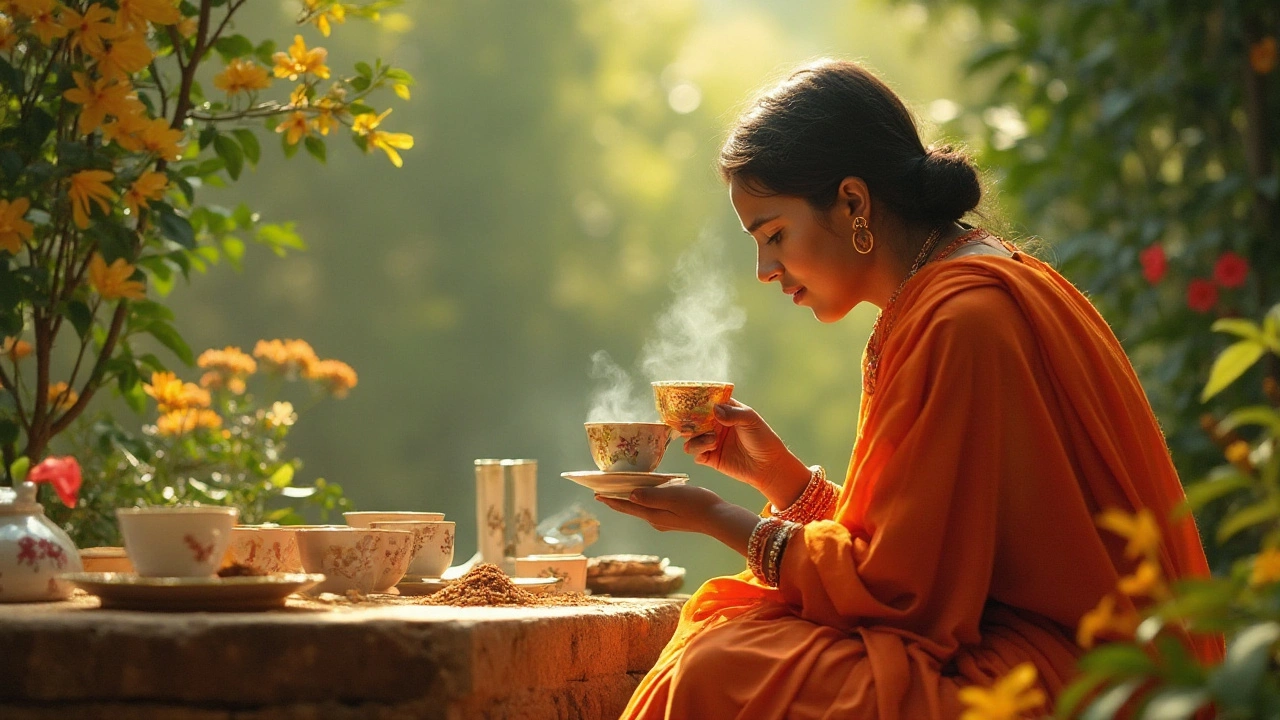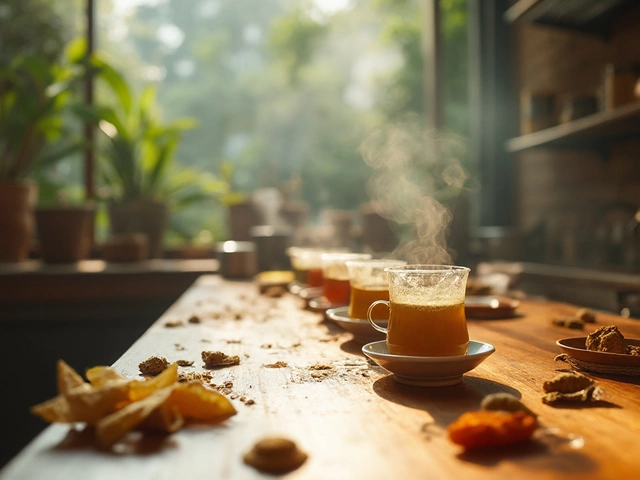
Sitting down to a cup of freshly brewed tea is a moment of pure anticipation. While many may be tempted to dive right in, true tea enthusiasts know that the experience begins long before the first sip. It starts with a sensory exploration, where the art of tea drinking is elevated by an immersive ritual that celebrates its fragrant nuances.
As the steam curls from within the cup, bringing forth the delicate aroma, you're invited to pause and contemplate the unique bouquet presented to you. This is a time to explore the complex layers of scent that waft from the leaves, a precursor to the flavors that are about to dance across your palate. By taking this moment to embrace the olfactory experience, you set the stage for a more profound appreciation of the tea's character.
- Savoring the Aroma
- Visual Inspection
- Understanding Tea Origins
- The Role of Water and Temperature
- Appreciating the First Sip
Savoring the Aroma
In the world of tea tasting, the aroma is the gateway to understanding a tea's true essence. As you bring the cup to your nose, you're engaging in a tradition that dates back centuries, one that tea masters believe is essential for grasping both the flavor and intricacies of the brew. The aroma provides an immediate intuition about the quality and origin of the tea leaves. It's akin to reading the cover of a book before turning the pages—the scent offers the first impression, filled with promises of what the taste might unveil.
To savor this aromatic prelude, you'll want to take a gentle, deliberate sniff, as if introducing yourself to a new friend. Whether it's the floral notes of a delicate jasmine or the robust smokiness of a Lapsang Souchong, each inhalation is an invitation to journey through different worlds. A particular delight of tea rituals is the ability to detect these different layers. It's fascinating how varied the aromatic profiles can be, reflecting the unique terroir and methods employed in cultivation. Sensory expert James Norwood Pratt in his book "Tea Lover's Treasury" noted,
"Drinking the tea is only half the journey; the fragrance fills in the words of the story."His insight into the cyclical relationship between aroma and taste is a reminder of just how fundamental scent is.
When exploring a new tea, take note of specific aromas that distinguish it from others. These might include hints of hay, sweet fruits like apricots or lychees, or even more earthy elements reminiscent of wet moss. Remember that the fragrance can also indicate the tea's freshness; a vibrant aroma often points to recently harvested leaves. Stepping into this aromatic experience allows you to dive deeper into the culture and appreciation of teas. It offers a tangible sense of anticipation, setting the stage for the layers of flavor that follow. There is also a distinct pleasure in comparing your initial aromatic impressions with the flavors you taste, enhancing your understanding of the tea's complete profile.
Consider the diversity of scents as a spectrum, where the color grade and type of tea influence what you detect. For instance, green teas often bring a fresh, vegetal aroma, while black teas can be more robust and malty. This difference underscores the nuances that make tea tasting an ever-evolving practice. Enthusiasts and experts alike revere the interplay between aroma and taste, much in the way renowned oenologists describe the connection in winemaking. The olfactory sense is powerful enough to conjure memories, shift emotions, and deepen sensory experiences, thus transforming the simple act of drinking tea into a moment of reflection and connection.
Visual Inspection
The journey of tea begins with the eyes, as much as with the nose. Before any tasting or sipping, the visual inspection of the tea is a critical step in understanding what your cup holds. A careful glance gives clues about the quality and potential flavors waiting to unfold. When practicing tea tasting, paying close attention to the leaves' appearance offers insights into its origin, processing method, and eventual flavor profile.
When you examine the dry leaves, notice the color, size, and shape. High-quality teas often have a uniform structure and an appealing sheen. The shade of the leaves can speak volumes; green teas might be a vibrant emerald or a more subdued olive, indicating freshness and oxidation levels. On the other hand, oolong teas often feature a spectrum from green to dark brown, reflecting varying degrees of fermentation. As you observe, consider whether the leaves are whole, broken, or perhaps twisted into artistic shapes, each hinting at different stories of cultivation and craftsmanship.
The look of the wet leaves also plays a huge role in the inspection stage. Once brewed, unfurling leaves offer a display of transformation and life. This visual cue can reveal the care taken during harvesting and the skill applied during processing. Whole, fleshy leaves typically suggest gentle handling and high quality, whereas broken or fragmented leaves may indicate industrial processing. Such details can profoundly affect the tea tasting experience, influencing everything from mouthfeel to aroma.
Appreciating the Color of the Infusion
The color of the brewed tea is another visual delight. Depending on the type, it can be anything from the delicate pale gold of a white tea to the deep amber of a robust black tea. The clarity of the liquid provides evidence of its purity and quality. A cloudy or murky brew might suggest contaminants, while a clear, bright cup generally indicates good quality leaves and proper handling. Paying attention to these nuances allows you to anticipate flavor nuances and prepare your palate accordingly.
"Careful examination of the leaves unveils the history and future of your cup, a tale captured in visual elegance," remarked renowned tea sommelier, Sebastian Beckwith.
In summary, taking the time for a thorough visual inspection before tasting is not just an exercise in aesthetics, but an integral part of the ritual of tea. By becoming a keen observer, you heighten your awareness and understanding, turning the act of drinking tea into a full-bodied experience, rich with details both seen and unseen. Such careful observation primes the senses, allowing for a truer appreciation of the tea tasting journey that lies ahead.

Understanding Tea Origins
Exploring the origins of tea is akin to embarking on a journey around the globe. Each cup tells a unique story that stretches back centuries, rooted deeply in the soil, climate, and culture of the regions from which the leaves derive. Understanding the birthplace of your tea can enrich your tasting experience, offering insights into the subtle nuances that differ from one variety to another. In the tea world, these origins are more than a geographic label; they represent an intricate tapestry of history and tradition woven over generations.
Tea origins often influence the flavor profiles and aromas that characterize the different types of tea. For example, a Darjeeling tea, known as the "Champagne of teas," comes from the misty, romantic slopes of the Himalayas in India, and offers a distinct muscatel flavor that is unmatched. Meanwhile, Assam, another famed Indian tea, thrives in the low-altitude steamy valleys and offers a robust, malty brew. These regions, though geographically close, produce distinctly different teas due to their varied climate and terroir.
China, the birthplace of tea, hosts an array of varieties that showcase an impressive diversity. The lush hills of Hangzhou produce the exquisite Longjing (Dragon Well), a renowned green tea celebrated for its chestnut aroma and smooth flavor. In contrast, the Wuyi Mountains nurture rock oolongs with their expressive mineral notes, providing a journey back in time to the traditional methods of tea production. Japanese teas also command their own spotlight, where meticulous cultivation techniques yield vibrant green products like ceremonial matcha and delicate sencha.
In the modern world, the understanding of tea origins also encompasses sustainability and ethical production. Consumers today often seek assurance that their beloved brews are not only cultivated with care but also support local communities and environments. The Fair Trade movement and other certifications play a crucial role in maintaining the balance between heritage and contemporary practices, ensuring that the ancient art of tea-making continues to thrive responsibly.
"To drink tea is to imagine another world," writes Okakura Kakuzo in "The Book of Tea."
Embracing the myriad stories told by different teas, enthusiasts can connect with the lands they originate from, engage with the echoes of past generations, and immerse themselves in the cultural wealth that each cup provides.This connection between drinker and place is part of what makes tea not just a beverage, but a portal into a broader understanding of the world.
| Region | Prominent Tea | Characteristic Flavor |
|---|---|---|
| Darjeeling, India | Darjeeling | Floral, Muscatel |
| Assam, India | Assam | Bold, Malty |
| Hangzhou, China | Longjing | Chestnut, Smooth |
| Kagoshima, Japan | Sencha | Grassy, Sweet |
The Role of Water and Temperature
Embarking on a journey of tea tasting reveals that the essence of the experience is significantly influenced by water and temperature. These elements are not just base components of the beverage but are crucial in unlocking the full potential of a tea's character. Water quality, for instance, plays a pivotal role. The clarity, mineral content, and absence of impurities can alter the natural brilliance and taste of the tea. Hard water can mask the subtle notes while overly soft water might dilute the flavor, leaving the tea tasting flat and unengaging. It's widely recommended to opt for filtered or spring water, ensuring that the tea's perfume speaks clear and true.
Temperature is equally vital, acting as a catalyst for extracting the myriad flavors hidden within the leaves. Different types of tea have unique requirements. Delicate green and white teas call for lower temperatures, often hovering between 160°F to 185°F, to preserve their gentle flavors and prevent bitterness. On the other hand, robust black and some herbal varieties require higher temperatures, typically around 200°F to 212°F, to fully release their bold and complex notes. The Tea Enthusiast's Handbook suggests that "the perfect brew reveals the soul of the tea only when prepared at the correct temperature," emphasizing that patience and precision are key to tasting excellence.
Another critical aspect to consider is the steeping time. Even a slight deviation can greatly affect the beverage, leading to a mellow love affair with mild teas or a strong, tannic embrace with bold varieties. For an authentic experience, it's often best to follow recommended guidelines: two to three minutes for green teas, and up to five minutes for black teas. By adhering to these rules, you allow the full spectrum of flavors to develop, offering each cup as a celebration of its unique terroir and history.
To bring these principles to life, imagine a table set elegantly with an array of porcelain cups, each filled with a different type of tea. It's here where you can truly appreciate the alchemy of water and temperature. As each cup is brewed with care, the distinct aromas and flavors emerge, crafted by the precise conditions tailored to each leaf's needs. This attention to detail is no mere affectation; it is a testament to the centuries-old tradition that places value not only on what we consume but how we arrive at the moment of consumption.

Appreciating the First Sip
The first encounter between the lips and the liquid is, without a doubt, a pivotal moment in the art of tea tasting. This is when the flavors fully reveal themselves, evolving from the aromatic whispers we observed earlier into a symphony of complex tastes. It begins with the warmth of the brew meeting the tongue, where the initial impression is captured. This instant is about more than just flavor; it’s about texture, temperature, and the subtle balance of notes that linger, inviting you to explore deeper nuances.
Each first sip should be slow and contemplative. This isn't a rushed gulp; it is a deliberate act that respects the centuries-old traditions ingrained in every infusion. As you take the sip, let it roll around your mouth, inviting your taste buds to interact with its full range of qualities. This helps in distinguishing the tea's body—whether it's light and airy like a spring morning or bold, as robust as the afternoon sun. Acknowledging these subtleties transforms each tasting into a journey through its origin, connecting you to the regions and hands that nurtured its leaves. As tea expert Jane Pettigrew once said, “Tea is drunk to forget the din of the world,” reminding us that these moments are meant to be savored, a retreat into tranquility.
The duration the taste lingers in the mouth—referred to as the "finish"—is also crucial. A lasting finish indicates a well-crafted tea, whereas a short one may hint at weaker qualities. Tea masters believe in





Categories